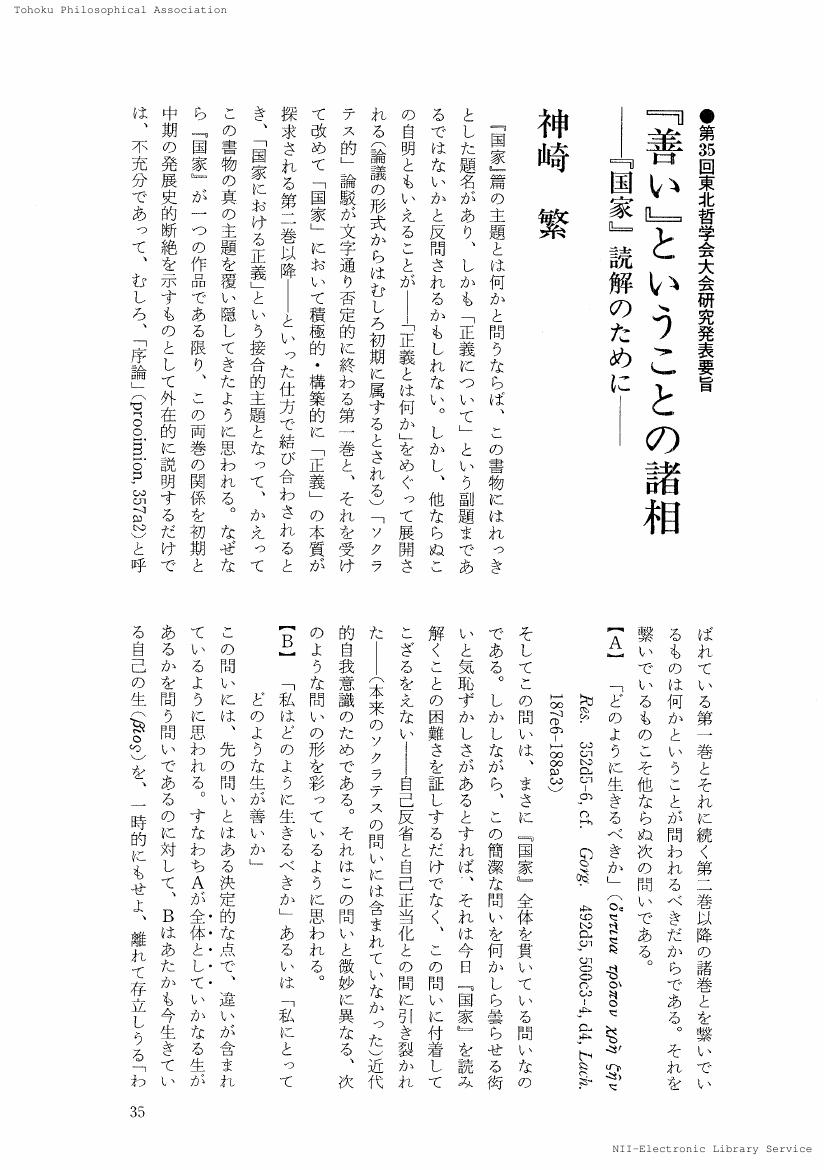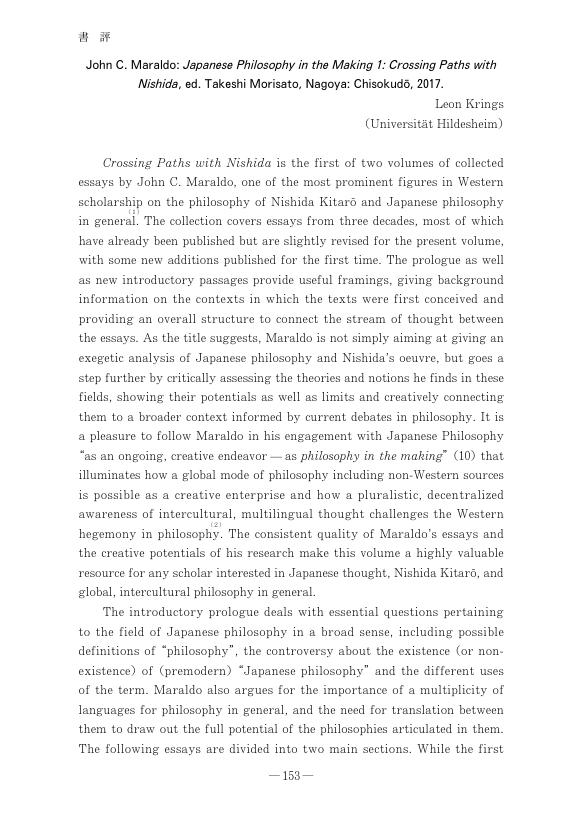1 0 0 0 OA 「共約不可能性」再考 (<シンポジウム>パラダイム論の哲学)
- 著者
- 野家 啓一
- 出版者
- 東北哲学会
- 雑誌
- 東北哲学会年報 (ISSN:09139354)
- 巻号頁・発行日
- vol.2, pp.27-32, 1986-05-10 (Released:2018-02-28)
1 0 0 0 OA 行為の因果性 : アクラシア問題を手掛に
- 著者
- 篠沢 和久
- 出版者
- 東北哲学会
- 雑誌
- 東北哲学会年報 (ISSN:09139354)
- 巻号頁・発行日
- vol.2, pp.33-34, 1986-05-10 (Released:2018-02-28)
1 0 0 0 OA 『善い』ということの諸相 : 『国家』読解のために
- 著者
- 神崎 繁
- 出版者
- 東北哲学会
- 雑誌
- 東北哲学会年報 (ISSN:09139354)
- 巻号頁・発行日
- vol.2, pp.35-36, 1986-05-10 (Released:2018-02-28)
1 0 0 0 OA ボエチウスの個体論
- 著者
- 坂口 ふみ
- 出版者
- 東北哲学会
- 雑誌
- 東北哲学会年報 (ISSN:09139354)
- 巻号頁・発行日
- vol.2, pp.37-38, 1986-05-10 (Released:2018-02-28)
1 0 0 0 OA 『ゴルゴーンをめぐるフロイトとヘーゲル』
- 著者
- 佐々木 俊三
- 出版者
- 東北哲学会
- 雑誌
- 東北哲学会年報 (ISSN:09139354)
- 巻号頁・発行日
- vol.2, pp.39-40, 1986-05-10 (Released:2018-02-28)
1 0 0 0 OA 現象学における動機づけの概念
- 著者
- 門脇 俊介
- 出版者
- 東北哲学会
- 雑誌
- 東北哲学会年報 (ISSN:09139354)
- 巻号頁・発行日
- vol.2, pp.41-42, 1986-05-10 (Released:2018-02-28)
1 0 0 0 OA プラトンの<数学的自然観>の背景
- 著者
- 種山(友村) 恭子
- 出版者
- 東北哲学会
- 雑誌
- 東北哲学会年報 (ISSN:09139354)
- 巻号頁・発行日
- vol.1, pp.1-17, 1985-03-25 (Released:2018-02-28)
- 著者
- 山本 建郎
- 出版者
- 東北哲学会
- 雑誌
- 東北哲学会年報 (ISSN:09139354)
- 巻号頁・発行日
- vol.1, pp.18-33, 1985-03-25 (Released:2018-02-28)
- 著者
- 天野 正幸
- 出版者
- 東北哲学会
- 雑誌
- 東北哲学会年報 (ISSN:09139354)
- 巻号頁・発行日
- vol.1, pp.34-38, 1985-03-25 (Released:2018-02-28)
1 0 0 0 OA カントにおける超越論的論証の問題
- 著者
- 遠藤 寿一
- 出版者
- 東北哲学会
- 雑誌
- 東北哲学会年報 (ISSN:09139354)
- 巻号頁・発行日
- vol.1, pp.39-41, 1985-03-25 (Released:2018-02-28)
- 著者
- 古川 英明
- 出版者
- 東北哲学会
- 雑誌
- 東北哲学会年報 (ISSN:09139354)
- 巻号頁・発行日
- vol.1, pp.42-44, 1985-03-25 (Released:2018-02-28)
1 0 0 0 OA デカルトの直観概念
- 著者
- 中村 文郎
- 出版者
- 東北哲学会
- 雑誌
- 東北哲学会年報 (ISSN:09139354)
- 巻号頁・発行日
- vol.1, pp.45-46, 1985-03-25 (Released:2018-02-28)
1 0 0 0 OA フッサールの「基体」概念
- 著者
- 佐藤 英明
- 出版者
- 東北哲学会
- 雑誌
- 東北哲学会年報 (ISSN:09139354)
- 巻号頁・発行日
- vol.1, pp.47-49, 1985-03-25 (Released:2018-02-28)
1 0 0 0 OA ヘーゲルの自己意識論
- 著者
- 太田 直道
- 出版者
- 東北哲学会
- 雑誌
- 東北哲学会年報 (ISSN:09139354)
- 巻号頁・発行日
- vol.1, pp.50-52, 1985-03-25 (Released:2018-02-28)
- 著者
- Leon Krings
- 出版者
- 西田哲学会
- 雑誌
- 西田哲学会年報 (ISSN:21881995)
- 巻号頁・発行日
- vol.16, pp.153-145, 2020 (Released:2020-08-10)
1 0 0 0 OA 「永遠の今」と死の自覚 永遠の今の一点を離れぬ無限の足蹈
- 著者
- 石井 砂母亜
- 出版者
- 西田哲学会
- 雑誌
- 西田哲学会年報 (ISSN:21881995)
- 巻号頁・発行日
- vol.16, pp.22-41, 2020 (Released:2020-08-10)
Kitaro Nishida declared, “The emotion which drives us to philosophical thinking must be not ‘surprise’ but profound sorrow for our life.” He had regarded “the self-awareness of death” as the most important subject of philosophy consistently. The death was not other people’s affairs but “the most concrete and individual event” for him. Whenever the past is recalled with regret in “the self-awareness of death”, the meaning of our life must become questionable. Since 1930, Nishida had searched after the meaning of our life by using the expression “the self-determination of eternal now”. According to Nishida, the self-awareness which must be thought ultimately as the self-awareness of absolute nothingness contains a contradiction. It means that present passes away as it stands still. Therefore, the self-awareness should be interpreted as “the self-determination of eternal now”. In my article, I would like to clarify the structure of “the self-awareness of death” from the viewpoint of Nishida’s theory of time.
1 0 0 0 OA くり返す時・消え行く時 ハイデガーの時間論・M、九鬼周造、西田幾多郎
- 著者
- 松本 直樹
- 出版者
- 西田哲学会
- 雑誌
- 西田哲学会年報 (ISSN:21881995)
- 巻号頁・発行日
- vol.16, pp.58-77, 2020 (Released:2020-08-10)
Im vorliegenden Aufsatz vergleiche ich, unter Berufung auf die Gedanken Martin Heideggers, die Überlegungen von Nishida Kitarō und Kuki Shūzō zum Wesen des ewigen Jetzt. Kuki bezeichnet die phänomenologische, von Heidegger als Zeitlichkeit explizierte Struktur der gewöhnlichen Zeit als horizontale Ekstase. Davon unterscheidet er die vertikale Ekstase, auf deren Grundlage seine eigene metaphysische Idee der kreisförmigen, wiederkehrenden Zeit erst denkbar wird und die es uns ermöglicht, unser eigenes, zufälliges und einmaliges Leben in seiner ewigen Bedeutsamkeit ernsthaft zu erfassen. Diese Auffassung hat offensichtliche Parallelen zu Nishidas Idee der Selbstbestimmung des ewigen Jetzt als absolutes Nichts: Dort meint dieser Begriff nämlich, dass nur in einer “vertikalen” Selbstbestimmung das zufällige und einmalige Einzelne erkannt werde, das über jegliches Allgemeine hinausgehe. Dieses vertikale Moment der Zeitlichkeit ist aber auch für Heideggers Zeitlehre wesentlich, der zufolge das Dasein erst dann im eigentlichen Sinne, nämlich als eigentlich vereinzeltes, existiert, wenn es seinem eigenen Nichts, d. h. seinem Tod, gegenübersteht. Nishida und Heidegger erkennen in der vertikalen Richtung der Ekstase das Phänomen des Nichts, in dem die horizontale Ekstase der Zeitlichkeit insgesamt verschwindet und aus dem heraus sie erneut entsteht. In diesem Prozess erweist sich ihre Unumkehrbarkeit. Dagegen hält Kuki die vertikale Ekstase gerade für den Grund der Umkehrbarkeit der Zeit. In der folgenden Diskussion versuche ich zu zeigen, dass Kukis divergierende Deutung darin begründet ist, dass seine metaphysische Zeitlehre zum ästhetischen Genuss und zur “Ideation” der Zufälligkeit und Einmaligkeit des eigentlichen Einzelnen tendiert.
1 0 0 0 OA 他者のための〈死〉 田辺元の宗教哲学における死復活をめぐって
- 著者
- 浦井 聡
- 出版者
- 西田哲学会
- 雑誌
- 西田哲学会年報 (ISSN:21881995)
- 巻号頁・発行日
- vol.16, pp.78-97, 2020 (Released:2020-08-10)
Tanabe Hajime (1885‒1962) started developing his philosophy of religion which he dubbed ‘philosophy as metanoetics’ since the autumn of 1944. In December of the same year, Nishida Kitaro (1870‒1945) criticized his understanding of the philosophy of religion, pointing out that its core concept of ‘repentance’ (zange) reduces to a mere ethical notion. Is this criticism justified? This paper aims to answer this question by indicating that Tanabe’s philosophy of religion is synthesis of ethics and religion, rather than a reduction of the latter to the prior. That is, I will clarify the relation between Tanabe’s notions of salvation (to which he referred to with the term ‘resurrection’) and existential communion (a term pertaining to social ontology that stands for the community of people who have been resurrected). For Tanabe, resurrection occurs when our practical reason is faced with an antinomy of duties and fails to find a solution; we are thus ‘resurrected’ by the Absolute. Resurrection leads naturally to new antinomies, which bring about higher demands for salvation. In this continuous process, we can gradually come to mediate the antinomies between oneself, others and entire communities. On the one hand, we can only realize existential communion by continuing ethical practices in our community. On the other, our salvation is attested only by existential communion. In this way, ethics and religion are inseparable in Tanabe’s philosophy of religion.
- 著者
- Steve G. Lofts
- 出版者
- Nishida Philosophy Association
- 雑誌
- 西田哲学会年報 (ISSN:21881995)
- 巻号頁・発行日
- vol.16, pp.98-124, 2020 (Released:2020-08-10)
本論文は、エルンスト・カッシーラーと西田幾多郎の二つの哲学が共有し両者 の対話がそこにおいて生じるような場所を確立するために、これら二つの哲学を 比較する哲学的試みである。本稿で論じられるのは、カッシーラーと西田の企図 に共通する哲学的な意図が、西洋の形而上学的伝統の凝り固まった二元論の超克 にあること、またこのことは超越論哲学と生の哲学という、相反する二つの哲学 的見地を逆説的に統合することで成し遂げられるということである。本論はまず 彼らの哲学的な企てが持つこの逆説的な性格を、それぞれのベルクソン批判を検 討することによって明らかにする。そのうえで、カッシーラーと西田が、形而上 学的な二元論を生じさせてきた根本要因を捜して古代ギリシャ哲学全般に、また 特にアリストテレスの実体概念にまで立ち戻ることを見る。さらに両者それぞれ のヘーゲル哲学への関わり方を検討することで、両者の哲学的企図を構成する本 質的な諸要素の比較を行う。最後に、現実性と可能性(エネルゲイアとポテンチ ア)の存在論的カテゴリーの逆転という観点から、カッシーラーの「全き可能性」 の概念と西田の「絶対無」の概念を比較する。
1 0 0 0 OA 新資料 西田幾多郎「希臘倫理學 (1) 」
- 著者
- 秋富 克哉
- 出版者
- 西田哲学会
- 雑誌
- 西田哲学会年報 (ISSN:21881995)
- 巻号頁・発行日
- vol.16, pp.125-130, 2020 (Released:2020-08-10)















